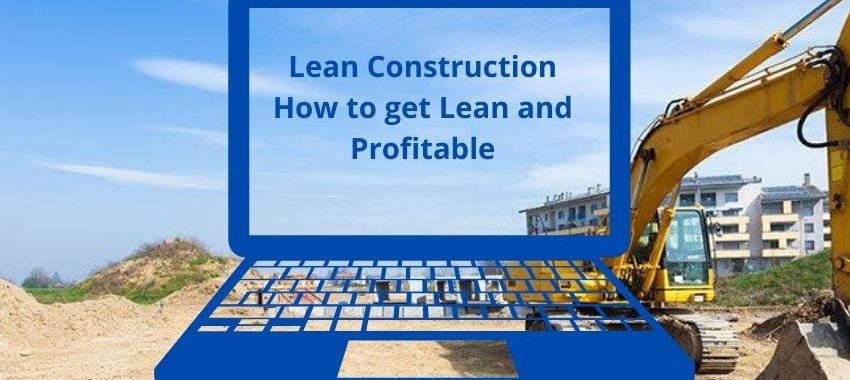
Lean Construction – How to Get Lean and Profitable
When we consider lean construction, the word “lean” is pretty much a dead giveaway.
Automatically we think of trimming the fat, eliminating waste, and running a lean project to positively impact profits.
Lean construction is, however, more about maximizing value through efficiencies, thus costs are impacted positively and are mitigated to the extent they will not affect the final value of a project.
It’s no secret in the construction industry that the lean construction concept is growing in popularity as construction managers share the benefits of the concept.
What are the Benefits of Lean Construction?
Construction contractors everywhere are enjoying additional profits and mitigating losses as they implement lean construction concepts in every major project. Getting lean is about getting the architects, general contractors, subcontractors, and project managers on the same page.
Certainly, since the lean construction concept will positively benefit all stakeholders in a project, the difficulty getting all parties together is minimal and takes minimal effort.
Make no mistake, the concept must be implemented at the beginning of a project and any parties who offer pushback at the onset should probably be considered for replacement.
Five Steps to Lean Construction
We agree with Kim Slowey at ConstructionDive.com that five steps make up the lean construction concept.
Project Sorting
Project sorting involves the elimination of project nonessentials even if they are tools, inventory, or outdated processes. When there is a non-essential inventory on a job site it’s like having pallets of cash sitting around that workers can trip over.
Project Organization
Being organized means having all project necessities stored properly but always available when needed. There’s a place for everything and everything needs to be in its place.
Project Cleanliness
When everything is in its place, there should be no clutter so the project will maintain a physical tidiness when all things are where they belong.
Project Standardization
Contractors need not reinvent the wheel. Every task can be replicated and as such, scheduled through the entire project thus making a bid more practical and within 100% completion.
Sustaining the Project
This involves replicating the first four steps so that every project remains lean and all parties to a project will never revert to the old ways of doing things. In other words, the wheel has been invented no need to reinvent the wheel.
Steps in getting Lean Construction embedded in Company Culture
To embed the culture of lean construction, all employees must be on board and stay on board. The simplest way to achieve buy-in from all employees, subcontractors, and consultants is to offer a bonus to those who support the concept and re-assign any who do not.
Consider taking a development and empowerment philosophy with employees as if they were stakeholders in the project. Moreover, remember that their inefficiencies will become your inefficiencies.
Believe it or not, construction projects require a level of analytics so that all aspects of the lean construction project can be measured and repeated.
Technology is Your Best Friend
The days of your granddaddy’s construction management process have been washed away along with the 20th Century. Please don’t misunderstand, the old days of construction projects aren’t gone, the methods haven’t changed but the implementation has.
Technology allows all construction stakeholders to measure their time and labor costs against the bid presented, and then determine whether or not the bid fell short of the mark or may have been more competitive.
Every task must be measured in terms of time, labor, and materials to establish the cost of the task. The good news is that this measurement needs to be taken only periodically because construction methods are not known to change as frequently as other industries.
It’s important, however, to accept that changes will take place and when they do, the task must be re-measure to ensure that it is a time saver or a time-waster. Certainly, just because something new appears more efficient, doesn’t mean it is when applied on the job site.
In what areas can my Business become Leaner?
Every aspect of your construction business should be considered when it comes to trimming expenses and becoming leaner.
Construction managers should examine every part of the organization that is attributed to the cost of doing business. Nothing is sacred and generally, all areas can accommodate some form of trimming.
For example, the method you are using to purchase materials for a project may be outdated. Materials should be purchased on an as-needed basis and delivered to the job site on a last-minute basis
The same argument could be made for employees or subcontractors. Having a standby reliable crew makes much more sense than hiring frantically because the labor pool has diminished or you didn’t reach out in advance to the usual list of subcontractors and get a commitment on when you’ll need them at the project and how long you’ll need them to commit to it.
The Bottom Line
The reality of construction projects is that insurance, bonds, labor, and materials, are going to cost whatever they cost. Yes, you may be able to cut some fat in each category but realistically, the cost of each is likely to increase year over year.
Your best method to realize a greater profit on any construction project is to implement a well-designed and well-implemented Lean Construction concept and simply rinse and repeat with every bid you win.
Contractors can also implement an insurance cost reduction plan by using job-safety measures to reduce the cost of workers’ compensation insurance as well as reduce claims against general liability policies. To have us review all of your contractors’ insurance policies, simply get in touch at your convenience.
Here is What We Recommend
General Liability: Contractors General Liability will be the foundation of protection for your business. The coverage will respond if you or your employees are found liable for bodily injury, property damage, or have a products/completed operations complaint. The coverage also covers defense costs for your business to respond to any lawsuits brought by a third party.
Workers’ Comp: Many states will require contractors to provide workers’ compensation coverage for their workers before they can begin a project. Accidents will happen at the job site that can result in an employee becoming injured and missing work. Your workers’ compensation coverage will provide financial assistance for medical expenses and lost wages.
Surety Bonds: It’s very likely that your state will require you to be licensed before you can begin operations. Most states and customers will require contractors to offer a license or surety bond before you are allowed to bid on a job or begin working.
Commercial Auto: Typically, most contractors will have light and heavy vehicles that require commercial auto insurance to make certain their vehicles can be repaired or replaced in the event of an accident, vandalism, or theft.
Tool Coverage: Also known as Inland Marine Insurance, this policy will provide for reimbursement for expenses to repair or replace tools and equipment. Your tools represent an important part of your livelihood, so we always encourage carpentry contractors to consider this valuable coverage.
Get A Quote

